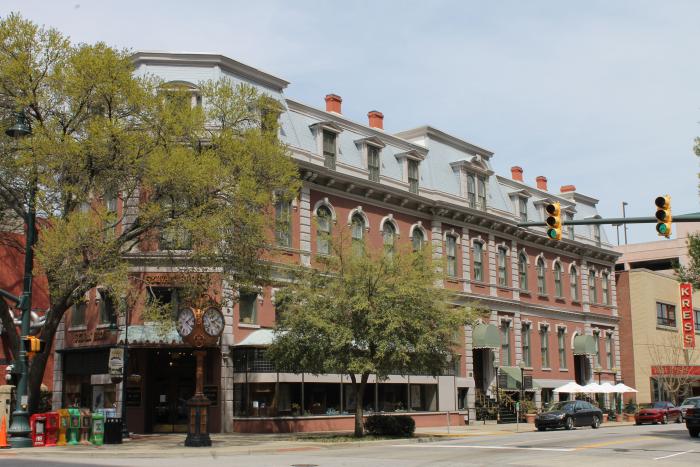Columbia Commercial Historic District
National Register Listing
Street Address:
portions of Main, Blanding, Taylor, and Sumter Sts., Columbia, SC (Richland County)
NRHP Nomination
Boundary Increase
Additional Documentation
Boundary Increase II and Additional Documentation II
Record Number:
S10817740158
Description and Narrative:
The Columbia Commercial Historic District is significant in the areas of commerce and architecture. The district illustrates the evolution of commercial patterns on Main Street from 1865 to 1963. The assemblage of buildings north of the State House within the 1500, 1600, and 1700 blocks of Main Street and its cross-streets reflect the significance of the Main Street corridor as a commercial center and represent the densest concentration of buildings with integrity from Main Street’s height as one of Columbia’s central business districts. This collection of buildings illustrates broad patterns in Columbia’s social history, including the transformation from locally-owned specialty stores and dry goods stores to national chains, five and dime stores, and department stores. These shops were a social and economic center for Columbia from the end of the Civil War until the Civil Rights Movement. The popular national chain stores on Main Street were not only the city’s main shopping destinations, but their lunch counters were also the site of student sit-ins and racial integration in the early 1960s precisely because these commercial spaces were viewed as a modern-day public square. Included are many architectural styles that are no longer found elsewhere in the city, such as Second Empire, Richardsonian Romanesque, Streamline Moderne, and Art Deco. The district also reflects the continuous and ongoing attempts of business owners to update their storefronts in order to stay conform to shifting architectural styles and meet the evolving expectations of their customers. Many of these remodeled storefronts were designed by prominent local architects or by nationally-known company architects. The nominated district includes 36 contributing properties, 1 contributing object, 16 non-contributing properties, and 1 non-contributing object. Listed in the National Register October 20, 2014. The two buildings included in this boundary increase (1222-1224 Taylor St.) were originally excluded from the district because they had an aluminum slipcover facade that was added in the 1980s. At the time the district was listed on October 20, 2014 the buildings did not retain sufficient integrity from the period of significance to be included in the district. Since that time, however, the aluminum slipcover has been removed, revealing that the storefronts and facades of the two buildings were substantially intact and appeared as they had during the district’s period of significance (1865-1963). 1222 Taylor St., which was built in 1914 and remodeled in 1936, housed Rose-Talbert Paints from 1936-1977. 1224 Taylor St., with its symmetrical storefront and simple one-over-one windows on the second level, was built in 1940. It was designed by Wessinger and Johnson associated architects and erected for E.L. Greever. The Western Auto Company, which operated 235 stores in 1940, leased the building upon its completion. They utilized the first floor for retail sales and the second floor for stock. When the slipcover was removed it revealed the original red-and-white enameled “Western Auto” sign, which remained intact. Boundary increase approved February 28, 2017. A second boundary increase and additional documentation added notable examples of late commercial architecture on Main, Sumter, and Blanding streets that were not yet fifty years old at time of the original listing but which subsequently aged into contributing status. Most of these properties reflect designers’ growing emphasis on functionality over ornamentation, the most notable exception being King’s Jewelers, which includes a 1970 punched-metal slipcover that is one of the few remaining examples of this trend in downtown Columbia. Six contributing and one non-contributing properties were incorporated into the district as part of this increase, including two properties that were already within the district but were previously non-contributing. Second boundary increase and additional documentation approved January 21, 2021.
Period of Significance:
1865 – 1970
Level of Significance:
Local
Area of Significance:
Commerce;Architecture
National Register Determination:
listed
Date of Certification:
October 20 2014
Date of Boundary Increase:
February 28 2017;January 21 2021
